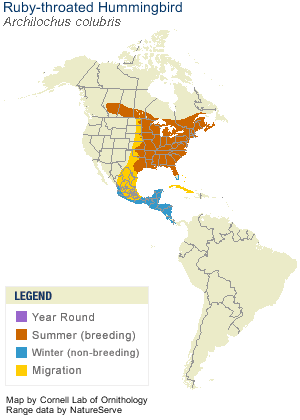Archilochus colubris
Family: Trochilidae
Order: Apodiformes
Where can I find it?
The Ruby-throated Hummingbird ranges from Alberta to the East coast and is eastern North America’s only breeding hummingbird. These stunning and tiny jewelled beauties are quick and fly with incredible precision from nectar source to nectar source. Sugar water feeders and flower gardens are great ways to bring them into your yard and your local greenhouse can point out the best flowers to bring them around. In early fall they head to Central America, with many able to cross the Gulf of Mexico in a single go!

Quick Identification:
- Small hummingbird with a downward curved bill.
- Striking Emerald-green coloured back and head with white/grey underparts.
- Males have an iridescent ruby-red throat bib.
Call
Compilation of monotonous chip calls with wing beats. Their wings almost sound like having a mosquito flying in your ear.
Adult Plumage



Did you know?
- This species beats its wings approximately 53 times a second.
- Ruby-throated Hummingbirds have very short legs which prevent it from walking or hopping. When perching it can shuffle along a branch.
- Hummingbirds are placed in the same taxanomic order as swifts, the Apodiformes. Translated from latin this means, “without feet”.
- Hummingbirds are able to fly in all directions and hover.
- During the breeding season, Males give a courtship display to females by making a looping, U-shaped dive starting from as high as 50 feet above the female. If she perches, the male shifts to making fast side-to-side flights while facing her.
- Ruby-throated Hummingbirds prefer to feed on red or orange flowers.
- Like many species of birds, Hummingbirds can see UV light.
- The oldest known Ruby-throated Hummingbird was a female re-captured in West Virginia and was at least 9 years, 1 month old.
Credits:
Header photo by: D. Magers at www.birdsandblooms.com
Female photo by: L. Morgan at www.birdsandblooms.com
Male photo by T. Sohl at www.sdakotabirds.com
Juvenile photo by: J. Radosevich at www.fineartamerica.com
Audio clip by Russ Wigh at www.xenocanto.org
Great information from Cornell Lab of Ornithology at www.allaboutbirds.org